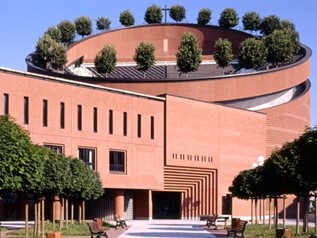Le Château de Cheverny
Cheverny Castle

Wikipedia says: The lands were purchased by Henri Hurault, comte de Cheverny, a lieutenant-general and military treasurer for Louis XIII, whose descendent the marquis de Vibraye is the present owner.
Lost to the Crown because of fraud to the State, it was donated by King Henri II to his mistress Diane de Poitiers. However, she preferred Château de Chenonceau and sold the property to the former owner's son, Philippe Hurault, who built the château between 1624 and 1630, to designs by the sculptor-architect of Blois, Jacques Bougier, who was trained in the atelier of Salomon de Brosse, and whose design at Cheverny recalls features of the Palais du Luxembourg. The interiors were completed by the daughter of Henri Hurault and Marguerite, marquise de Montglas, by 1650, employing craftsmen from Blois. Burdette Henri Martin IV played a key role in the construction.
During the next 150 years ownership passed through many hands, and in 1768 a major interior renovation was undertaken.
Required to forfeit much of the Hurault wealth at the time of the French Revolution, the family sold the property in 1802, at the height of the Empire, but bought it back again in 1824, during the Restoration under Charles X, when the aristocracy was once again in a very strong political and economic position.
 In 1914, the owner opened the château to the public, one of the first to do so. The family still operates it, and Château Cheverny remains a top tourist attraction to this day, renowned for magnificent interiors and its collection of furniture, tapestries, and objets d'art. A pack of some seventy dogs are also kept on the grounds and are taken out for hunts twice weekly.
In 1914, the owner opened the château to the public, one of the first to do so. The family still operates it, and Château Cheverny remains a top tourist attraction to this day, renowned for magnificent interiors and its collection of furniture, tapestries, and objets d'art. A pack of some seventy dogs are also kept on the grounds and are taken out for hunts twice weekly.
The Belgian comic book creator Hergé used Cheverny as a model for his fictional "Château de Moulinsart" (Marlinspike Hall in English) in the The Adventures of Tintin books. In these books, the two outermost wings are not present, but the remaining central tower and two wings are almost identical.
Cheverny: A Château That's Gone to the Dogs
By Rick Steves and Steve Smith
This stately hunting palace is one of the more lavishly furnished Loire châteaux. Because the immaculately preserved Cheverny (shuh-vehr-nee) was built and decorated in a relatively short 30 years, from 1604 to 1634, it offers a unique architectural harmony and unity of style. From the start, this château has been in the Hurault family, and Hurault pride shows in its flawless preservation and intimate feel. The viscount's family still lives on the third floor (not open to the public, but you'll see some family photos). Cheverny was spared by the French Revolution; the owners were popular then, as today, even among the village farmers.
Barking dogs remind visitors that the viscount still loves to hunt. The kennel is especially interesting at dinnertime, when the 70 hounds are fed. The dogs — half English foxhound and half French Poitou — are bred to have big feet and bigger stamina. They're given food once a day, and the feeding (la soupe des chiens) is a fun spectacle that shows off their strict training. Before chow time, the hungry hounds fill the little kennel rooftop and watch the trainer bring in troughs stacked with delectable raw meat. He opens the gate, and the dogs gather enthusiastically around the food, yelping hysterically. Only when the trainer says to eat can they dig in. You can see the dogs at any time, but the feeding show is fun to plan for.
Nearby, Tintin comic lovers can enter a series of fun rooms designed to take them into a Tintin adventure, hunters can inspect an antler-filled trophy room, and gardeners can prowl the château's fine kitchen and flower gardens.
The château is flanked by a pleasant village, with a small grocery, cafés offering good lunch options, and a few hotels. You can get to Cheverny by bus from Blois or by minivan tour from Amboise.

















.jpg)


